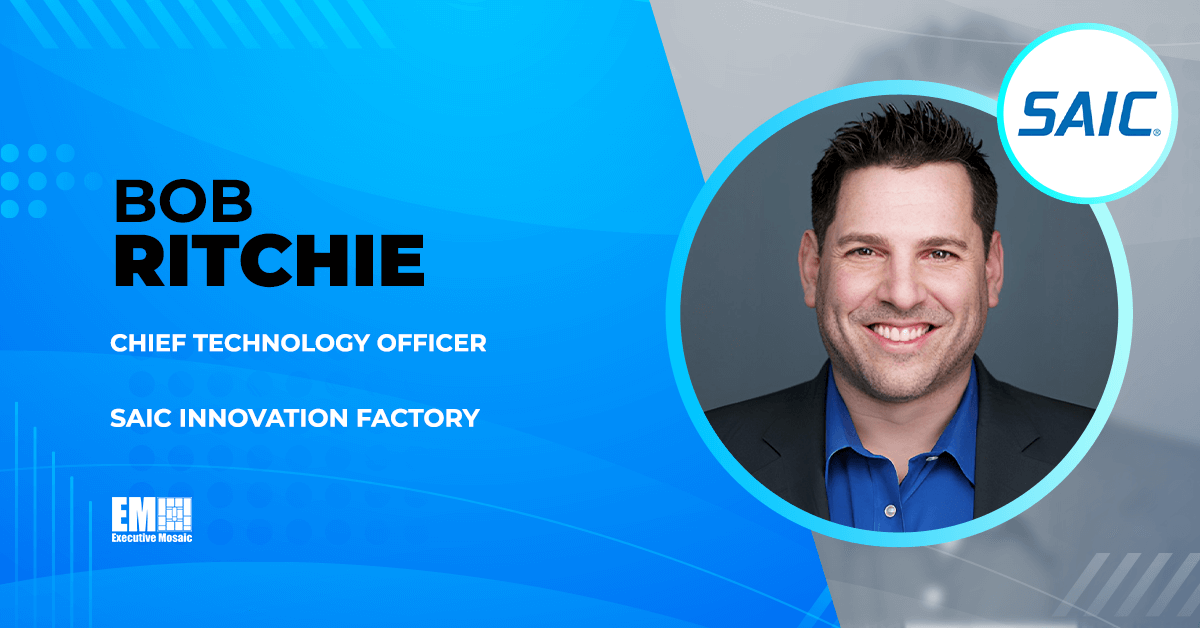Bob Ritchie is a fast learner. The technologist started at SAIC as an intern fresh out of a Virginia Tech computer engineering degree and only three years later was the chief software architect assisting the U.S. Navy and Marine Corps, wherein he helped digitally transform preexisting Department of Defense tactical decision and command and control, or C2, systems. He’s remained committed to the company for his whole career, staying on part-time when he eventually went to pursue a new opportunity at Capital One in the latter part of the 2010s. At Capital One he stewarded a large-scale migration to the Amazon Web Services public cloud.
Given his astounding fast-track career and quickly accruing technical acumen, it’s no surprise that he was appointed chief technology officer of the SAIC Innovation Factory in 2022. He is proud to play a role in a first-of-its-kind secret releasable cloud-based software factory and in the DOD’s Cloud One enterprise.
GovCon Wire recently had the chance to speak with Ritchie about the most prevalent technology du jour: artificial intelligence. It’s no surprise that he had much insight to share about what the federal government is currently looking for with AI systems and where the field is going next.
GovCon Wire: In which applications are you seeing the highest demand for AI/ML from your federal customers, and can you explain what’s driving that demand?
Bob Ritchie: The demand I see across the federal government landscape typically falls into two segments. The first is what I would frame as productivity demand and is almost entirely dominated by the large language model, retrieval augmented grid and large action model marketplace. Specifically, within the federal government this market has been hyper-focused on how to safely and securely leverage closed and open-source models to offload monotonous and error-prone aspects of business and mission workflows. This segment is not unlike predecessor technologies such as robotic process automation, just with a dramatically more powerful set of tools in the toolbox.
The second segment, and candidly, the more challenging one, is the continued development and advancement of models that provide insights and foresights in near real-time and move into the realm of predictive and prescriptive analytics. Whether driven by great power competition in the national security and defense space, improved total experience of citizen services, or conquering new frontiers in autonomous systems in space, air, land and sea, the demand for truly operationally ready and relevant AI solutions is at an all-time high.
GovCon Wire: Where do you think AI is headed next?
Bob Ritchie: One fundamental direction that solutions in AI will focus on is governance, transparency and explainability. Not too far a cry away from the marketing/influence perspectives of old—“four out of five dentists agree”—for people to accept recommendations and/or take advantage of machine-to-machine decision-making requires an enhanced level of understanding and trust in the output.
Over the past 20 years I have been a part of several AI/ML user acceptance test scenarios where the solution was rejected for reasons that could be paraphrased as, “well this can’t be right because it is not the way I would have done it.” Whether utilizing mixture-of-experts models, orchestrating recursive multi-shot action models, or providing advanced visualization of nested probabilistic decision trees, there are many options available to improve the accuracy, relevancy, context and explainability of AI-based solutions. Given the current barriers in the cost and availability of compute power and the exhaustion of publicly available training data sets, the near-term advancements in AI will all center around how to efficiently balance fine-tuning and fit-for-purpose models in conjunction with state-of-the-art LLMs.
GovCon Wire: Data must be collected, analyzed and understood to be used effectively. And it’s a key to AI systems running effectively. What are some of the key challenges and opportunities you’re seeing emerge as organizations harness data and use it to drive decisions?
Bob Ritchie: It is almost cliché to say at this point but one of the key challenges and opportunities that has been ever present is the lack of good data hygiene as a starting point within organizations. Many organizations want to jump in with both feet and take advantage of large language models, but many don’t have their data house properly organized enough to truly realize the value proposition. The interesting phenomena, however, is that organizations that understand this gap as well as the limits of large language and/or action models can leverage those same models to greatly expedite the toil of understanding the organization’s data and even establish semi-automated processes to define, refine and maintain semantic ontologies that in turn remove the barrier.
Another challenge is the cost and impacts of the raw compute power necessary to keep up with existing demand, especially when it comes to inference in operationally relevant scenarios. Many companies have leaned into this innovation opportunity to develop alternative chip architectures that greatly outperform GPUs when it comes to inference, and I expect to see many more fit-for-purpose chip architectures emerge in kind.
GovCon Wire: In your opinion, what will zero trust success look like, and what is SAIC doing to help federal customers achieve that success?
Bob Ritchie: One of the beauties of zero trust as an ethos is that there is no ambiguity in its objective. How much trust? Zero. Like anything else, however, there is an objective and there is a threshold for success, and it all begins with a ruthless dedication to minimizing implicit trust to maximize the protection of data. SAIC has been a pioneer in architecting and implementing the journey from net-centric solutions to the future data-centric ecosystem that spans the federal government and our allies. By embracing that zero trust is a journey, balancing innovation and speed with evidence, risk management and objective policy change recommendations, and collaborating openly across industry and the federal government, SAIC is committed to ensuring that the right data, in the right context, at the right time, to the right resources is securely accessible and drives truly differentiated mission outcomes.



